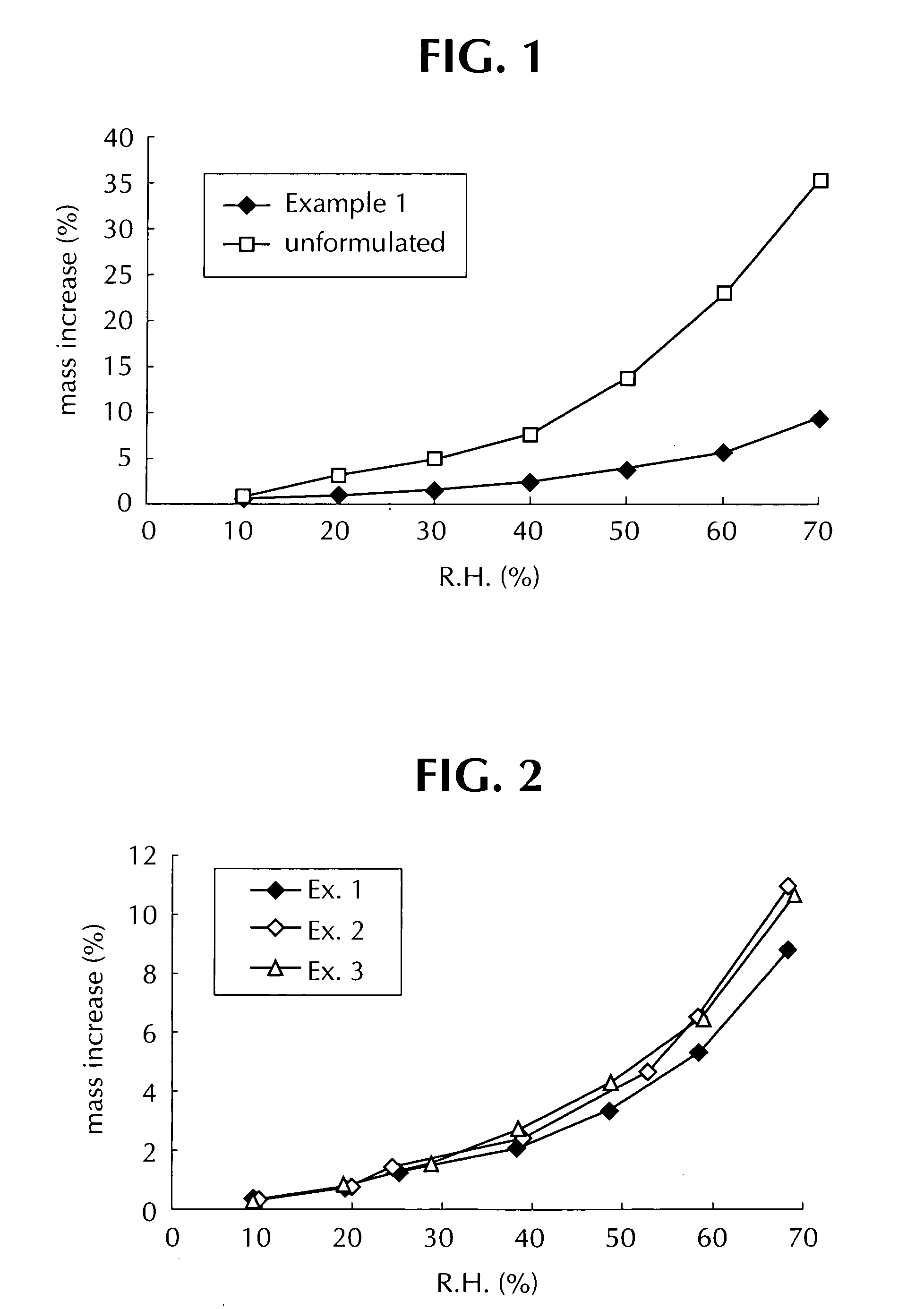Solid dispersions comprising a hygroscopic and/or deliquescent drug
a technology of solid dispersions and hygroscopic and/or deliquescent drugs, which is applied in the direction of extracellular fluid disorder, immunological disorder, metabolism disorder, etc., can solve the problems of adversely affecting the release rate of the substance from the formulation, the shelf life of the formulation, the hygroscopic and/or deliquescent drug, etc., to achieve better handling and processing properties, and more resistant to moisture absorption
- Summary
- Abstract
- Description
- Claims
- Application Information
AI Technical Summary
Benefits of technology
Problems solved by technology
Method used
Image
Examples
example 1
Solid Dispersion of the Invention
[0071] A solid dispersion having the ingredients shown in Table 1 was prepared by the method described below.
TABLE 1Composition of solid dispersion of Example 1IngredientQuantity (mg)Compound A, lyophilized powder25.53Carbowax ™ 8000175.15Avicel ™ PH-101225.60
1PEG 8000
[0072] A capped 7 ml glass vial containing the PEG 8000 was placed in a 68° C. water bath and stirred, with the aid of a small magnetic stirrer, at a low rotation speed until the PEG 8000 had melted. Lyophilized Compound A was placed in a separate 2 ml glass vial to which 1.0 ml methanol was then added. The 2 ml vial was then capped and sonicated for 5 minutes to obtain a clear solution.
[0073] This solution was then added to the PEG 8000 in the 7 ml vial under constant stirring in the 68° C. water bath for 5 minutes. Then, with continuing stirring, the microcrystalline cellulose was added. The vial was uncapped and the resulting mixture stirred vigorousl...
example 2
Comparative Solid Dispersion
[0077] A solid dispersion having the ingredients shown in Table 2 was prepared by the method described below. It will be noted that the solid dispersion of this example differs from that of Example 1 in lacking a filler (microcrystalline cellulose).
TABLE 2Composition of solid dispersion of Example 2IngredientQuantity (mg)Compound A, lyophilized powder26.11Carbowax ™ 800075.98Avicel ™ PH-1010
[0078] A capped 7 ml glass vial containing the PEG 8000 was placed in a 68° C. water bath and stirred, with the aid of a small magnetic stirrer, at a low rotation speed until the PEG 8000 had melted. Lyophilized Compound A was placed in a separate 2 ml glass vial to which 1.0 ml methanol was then added. The 2 ml vial was then capped and sonicated for 5 minutes to obtain a clear solution.
[0079] This solution was then added to the PEG 8000 in the 7 ml vial under constant stirring in the 68° C. water bath for 5 minutes. The vial was then removed from the water bath an...
example 3
Comparative Composition
[0080] A composition having the ingredients shown in Table 3 was prepared by the method described below. It will be noted that the composition of this example differs from that of Example 1 in that the filler (microcrystalline cellulose) was blended with the solid dispersion after preparation of the solid dispersion.
TABLE 3Composition of Example 3IngredientQuantity (mg)Solid dispersion of Example 248.12Avicel ™ PH-10112.27
[0081] The product of Example 2 above was transferred to a clean 7 ml glass vial. The microcrystalline cellulose was added to the vial, which was then capped and mixed using a tubular mixer for 24 hours. The resulting composite was in the form of a sticky substance not readily suitable for tableting.
Comparison of Moisture Absorption by Compositions of Examples 1-3
[0082] As shown in FIG. 2, resistance to moisture absorption of the composition of Example 1 of the invention was superior to that of the comparative compositions of Examples 2 ...
PUM
| Property | Measurement | Unit |
|---|---|---|
| average molecular weight | aaaaa | aaaaa |
| molecular weight | aaaaa | aaaaa |
| temperatures | aaaaa | aaaaa |
Abstract
Description
Claims
Application Information
 Login to View More
Login to View More - R&D
- Intellectual Property
- Life Sciences
- Materials
- Tech Scout
- Unparalleled Data Quality
- Higher Quality Content
- 60% Fewer Hallucinations
Browse by: Latest US Patents, China's latest patents, Technical Efficacy Thesaurus, Application Domain, Technology Topic, Popular Technical Reports.
© 2025 PatSnap. All rights reserved.Legal|Privacy policy|Modern Slavery Act Transparency Statement|Sitemap|About US| Contact US: help@patsnap.com

